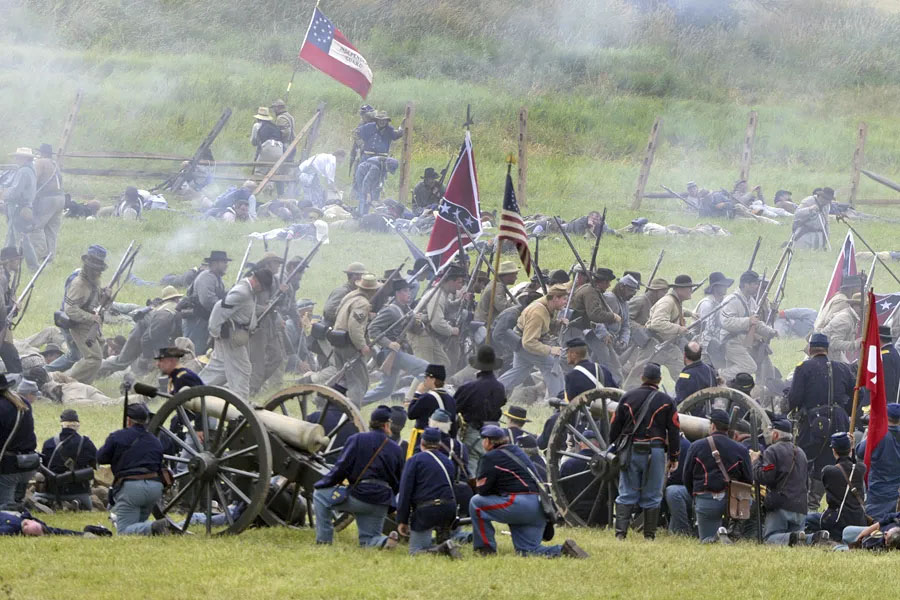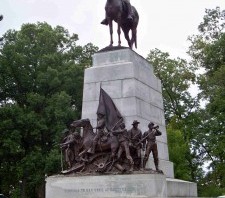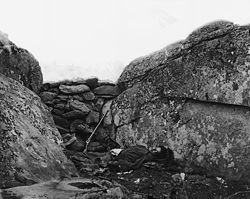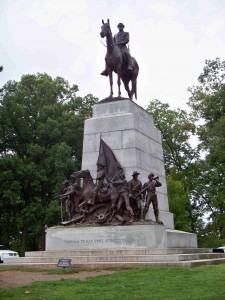Tag: Pickett’s Charge

Revisiting Pickett’s Charge: Marching into the Fire
March 30, 2023The Battle of Gettysburg is often identified as the definitive turning point in the American Civil War. Fought from July 1st to July 3rd, 1863, in and around the Pennsylvania town from whence it takes its name, the famous battle resulted in the loss of over 50,000 soldiers on both sides, making it one of the bloodiest engagements in American history.
One of the most famous and controversial moments of the battle was “Pickett’s Charge,” a failed Confederate direct assault against the Union battlefront that has since become a symbol of gallant bravery and terrible sacrifice. Even today, 160 years later, the grim details of that terrible feat still echo across the empty fields where that final, brutal charge took place, and where so many desperate Confederate soldiers faultlessly obeyed their orders to march into the fire.

The High-Water Mark: Revisiting a Pivotal Moment of the Battle of Gettysburg
July 19, 2022What is the High-Water Mark?
The High-Water Mark of the Confederacy or “high tide of the Confederacy” refers to an area on Cemetery Ridge near Gettysburg, Pennsylvania, marking the farthest point reached by Confederate forces during the action known as Pickett’s Charge on July 3, 1863. Like a high-water mark denoting a level of water, the term is a reference to arguably the Confederate Army’s best chance of achieving victory in the war. The designation “High-Water Mark” was formally evoked by historians in the years following the Civil War, based on the idea that the battle of Gettysburg was the turning point of the war.
26th North Carolina Infantry
March 10, 2016 Many visitors that come to Gettysburg question why there are so few confederate markers on the field. There are a number of reasons – #1 it was a confederate defeat #2 after the war the South was unable to financially channel many funds toward memorials and #3 the North plain & simple really didn’t want them here.
Many visitors that come to Gettysburg question why there are so few confederate markers on the field. There are a number of reasons – #1 it was a confederate defeat #2 after the war the South was unable to financially channel many funds toward memorials and #3 the North plain & simple really didn’t want them here.
One of the few markers here at Gettysburg that honors Confederate soldiers can be found on Meredith Ave. in Reynold’s Woods & belongs to the 26th North Carolina Infantry. Engaged with the Union Iron Brigade on July 1st, this unit suffered very heavy casualties. They would lose a total of 588 men which would be the greatest numeric loss of any Confederate unit during the battle. They would also participate in Pickett’s Charge on July 3rd & a companion marker can be found at the Angle which notes their position on that day.
Their memorials were dedicated on October 5, 1985.
Private Joseph Lindemuth, Company L, 1st Pennsylvania Cavalry
March 18, 2015
Private Joseph Lindemuth, Company L, 1st Pennsylvania Cavalry – fully equipped & down on one knee served as the model for his units monument at Gettysburg. Located on Hancock Avenue at the Angle during Pickett’s Charge on July 3rd, the memorial to these men was dedicated on September 2, 1890 & cost $1,500.00.
In position behind the crest of Cemetery Ridge, the 1st PA. Cavalry was held in reserve to be on hand to attack any confederate infantry that was able to break through the union front. The Confederate assault faltered at the wall & these troopers were not needed that day. The dedicated, watchful appearance that Private Lindemuth conveys on this memorial represents the anxious wait of his fellow troopers as they witnessed the struggle unfold in front of them.

Gettysburg Hotspots
November 14, 2014Even as the temperature starts to drop, the famous fields, provocative places, and memorable monuments still remain hotspots for visitors coming to witness historic Gettysburg. We’ve taken the time to put together a list of some of the popular locales that people look for when they visit so that you don’t miss any of these interesting hotspots on your next trip to see us. Have you been able to see them all?
Famous Places
- Where President Lincoln delivered his Gettysburg Address – Located just outside the Soldiers’ National Cemetery is a marker that lets you know Lincoln delivered his historic Gettysburg Address nearby. The exact location is disputed, but the National Park Service has a brochure declaring it to be within the private Evergreen Cemetery.

- Devil’s Den – One of the most significant and haunted battlegrounds on the Gettysburg battlefield, The Devil’s Den is roughly 500 yards west of Little Round Top. Surrounded by large boulders, a Confederate sharpshooter used this hideout to take out hundreds of Union soldiers before they discovered him.
- Little Round Top – Roughly two miles south of Gettysburg in Cumberland Township there are two rocky hills, one larger and one smaller. You can probably guess the smaller one is known as “Little Round Top.” While small in size, it still remained one of the most important positions in the Union line, and a key point for the Union’s defense during the second day of the Battle of Gettysburg.
- Pickett’s Charge – Located on Cemetery Ridge, this famous charge lead by General George Pickett was one of the defining moments of the Battle of Gettysburg. This ill-fated Confederate assault across the ridge would lead to over 6,000 Confederate deaths and would be Lee’s last invasion of the north, and came to signify the end of the Battle of Gettysburg.
Famous Monuments
- Peace Light Memorial –Also referred to as the Eternal Light Peace Memorial, this Gettysburg Battlefield monument was dedicated by President Roosevelt in July 1938. Featuring an eternal flame that is visible from 20 miles away, this granite monument commemorates the 1913 Gettysburg reunion of veterans that celebrated the 50th anniversary of the Battle of Gettysburg. It is located on Oak Hill.
- Virginia Monument – The first and largest Confederate monument built at Gettysburg, this 14-foot bronze statue of General Robert E. Lee shows him on his horse “Traveller,” above seven Confederate soldiers. The Virginia Monument is located southwest of Gettysburg on West Confederate Avenue.
- North Carolina Monument – Once again located on West Confederate Avenue, this monument commemorates the 32 Carolina regiments at that Battle of Gettysburg. This collection of troops only trailed Virginia in terms of men it supplied to the battle, but featured the largest number of casualties of all the Confederate states.
- Irish Brigade – South of Gettysburg on Sickles Avenue, and just inside the Rose Woods stands a bronze Celtic cross that commemorates the predominantly Irish American infantry brigade that served the Union army.
If you haven’t seen these amazing historic Civil War locations and monuments, we encourage you to pay them a visit on your next trip to Gettysburg. Since there’s so much to see and do in Gettysburg, this list should by no means be considered expansive, but it does cover many of our most asked about attractions.
If you’d like to learn more about these or other great spots to visit on your next Gettysburg trip, feel free to comment below or contact us and we’d be happy to help!
The “Harvard Regiment”
February 2, 2012“Scarcely any Union regiment was in the heart of the storm longer than the Twentieth Massachusetts,” says History Today magazine. They weathered through nearly every battle of the Army of the Potomac, and a few others to boot. At Gettysburg, the men defended a pivotal position during Pickett’s Charge—an assault that, if successful, could have turned the tide of the Civil War. For all that they accomplished, the War took its toll on them: they suffered the highest casualties of any Massachusetts regiment and the fifth highest in the Union.
Known as “The Harvard Regiment,” the 20th Massachusetts Volunteer Infantry was formed in Roxbury, MA. All of the officers, and a portion of the enlisted men, were Harvard graduates, hence the nickname. The regiment was catapulted into battle in October, 1861, a mere month out of basic training; it was four years before they laid down their weapons at the end of the war. Among the Harvard men who served was Oliver Wendell Holmes Jr., who would go on to be nominated to the Supreme Court by Teddy Roosevelt and be remembered as one of the most influential Justices in American history.
One “celebrity” of the Harvard Regiment was Colonel Paul J Revere, who was killed in the Battle of Gettysburg. He was the grandson of his namesake, the midnight rider and patriot of the American Revolution. An unusual monument—a puddingstone boulder—was erected in memory of Revere and the 43 other men of his company who died at the Battle of Gettysburg. The 30-ton colossus, dedicated in 1886, was imported by train from Roxbury, where many of the soldiers grew up. Now, it can be visited on Hancock Avenue, near the immortalized “copse of trees” and the Confederate High Water Mark.
For more monuments that “rock,” click here and here!

